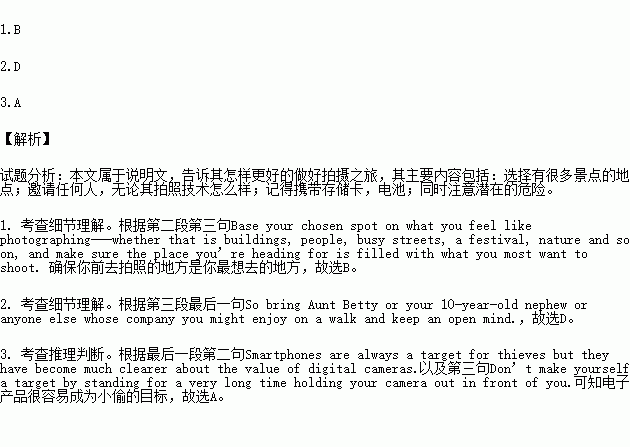题目内容
阅读下列短文,从每题所给的A、B、C、D四个选项中,选出最佳选项,并在答题卡上将该项涂黑。
A
Tips for Getting the Most out of a “Photo walk”
Photo walks are a great way to get out and get clicking, either by yourself, with a couple of friends, or with a group of people. They can be wonderful for seeing a neighborhood or wild space with new eyes, getting inspired to be more creative with angles and subjects, as well as simply spending time with fun people. Here are a few tips for making sure you get the most out of a photo walk.
Pick a spot with lots of interest
A photo walk is a perfect excuse to go exploring a new area. However, if you’ve never been to the scene before, you might be disappointed at the final photos. Base your chosen spot on what you feel like photographing---whether that is buildings, people, busy streets, a festival, nature and so on, and make sure the place you’re heading for is filled with what you most want to shoot. It will pay off in a satisfying walk if you research your chosen spot beforehand and know what to expect.
Invite anyone, no matter what their skill level is
You’ll be surprised at what you learn from people who seem to know nothing about photography. Even with a simple camera, they can catch some outstanding photos. So bring Aunt Betty or your 10-year-old nephew or anyone else whose company you might enjoy on a walk and keep an open mind.
Don’t forget them
Be sure to take the important small things, such as an extra memory card (or two), an extra fully charged battery, comfortable shoes and clothing. And remember a notepad and pen for taking down notes about places, times, conditions, the names and information of people you meet and any other information you might want to remember about certain shots.
Keep an eye out for danger
Apart from watching the sky for rain, you’ll want to watch out for other people as well. Smartphones are always a target for thieves but they have become much clearer about the value of digital cameras. Don’t make yourself a target by standing for a very long time holding your camera out in front of you. If you’re in an area that is really busy or you aren’t super comfortable, then just be careful about when to use your camera. Imagine your shot in your head before holding up your camera, or use a camera belt wrapped around your wrist or shoulder.
1.To choose a place for a photo walk, you are suggested to _______.
A. spend time discussing with fun people
B. decide the place on your interest
C. choose famous places
D. find a new area
2.The people you go photo walking with _______.
A. must know the area well
B. have learned photography
C. would like to explore the places for you
D. enjoy walking with you and keep an open mind
3.You are supposed to hold the camera around your wrist or shoulder in case _______.
A. it is stolen by a thief
B. it gets wet in the rain
C. it loses some information
D. it falls down on the ground
 寒假乐园北京教育出版社系列答案
寒假乐园北京教育出版社系列答案


 ),并在下面加上该加的词。
),并在下面加上该加的词。